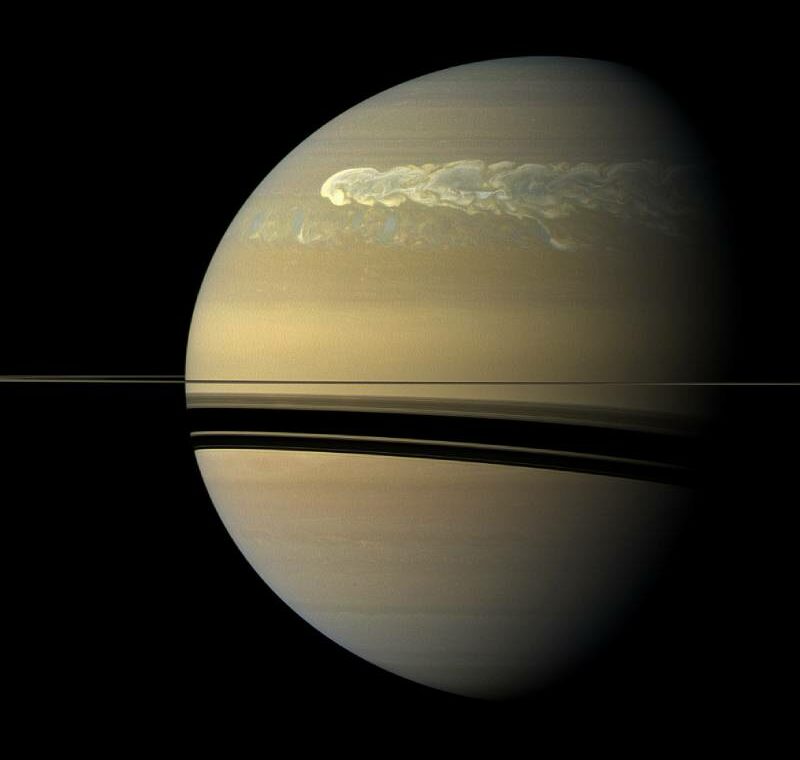Scientists have found that Saturn undergoes long-lasting megastorms that churn up its deep atmosphere and endure for centuries.
Saturn was once thought to be a little calmer than Jupiter, another gas giant in the solar system, which has been host to the Great Red Spot, a storm 10,000 miles wide, for hundreds of years. The newly discovered storms on Saturn are still strong enough to rival Earth’s hurricanes, even if the Great Red Spot is still the solar system’s greatest storm.
Thought to happen every 20 to 30 years, the megastorms of Saturn are akin to hurricanes on Earth but considerably more powerful. While hurricanes on Earth draw their power from the oceans, it is unclear what causes megastorms in Saturn’s atmosphere, which is rich in hydrogen and helium.
However, by examining changes in the distribution of ammonia gas in the planet’s deep atmosphere, astronomers from the Universities of California, Berkeley, and Michigan, Ann Arbor, have discovered further information about these storms on Saturn. In a release, University of Michigan assistant professor Cheng Li said, “Understanding the mechanisms of the largest storms in the solar system puts the theory of hurricanes into a broader cosmic context, challenging our current knowledge and pushing the boundaries of terrestrial meteorology.”
Li and the team used the Karl G. Jansky Very Large Array (VLA) in New Mexico to examine radio emissions from ammonia in Saturn’s atmosphere in order to find this disturbance. Saturn appears to be generally uniformly colored in visible light, but when observed in radio frequencies, its characteristic banding and the changes between atmospheric layers at various altitudes are more obvious.
This is due to the fact that radio observations can look farther into planets’ atmospheres than optical observatories can, which enables astronomers to comprehend the physical and chemical processes that contribute to cloud formation and heat transmission. UC Berkeley astronomer Imke de Pater noted in the release that “at radio wavelengths, we probe beneath the visible cloud layers on giant planets.” “Observations below these cloud layers are required to constrain the planet’s true atmospheric composition, a key parameter for planet formation models,” according to the statement that “chemical reactions and dynamics will alter the composition of a planet’s atmosphere.”
Surprising irregularities in ammonia concentrations were discovered by the scientists in radio waves coming from Saturn’s atmosphere. They were able to link these abnormalities to earlier megastorms that raged across the northern hemisphere of the gas giant.
In Saturn’s central latitudes, the ammonia content was lower, indicating a thicker covering of ammonia ice clouds. However, ammonia concentrations increased from around 160 to 320 miles (100 to 200 kilometers) below this. The research team believes that ammonia rain, which travels from the upper atmosphere to the lower atmosphere, is what causes this enrichment. Megastorms are the cause of this impact, which can continue for hundreds of years.
Saturn and Jupiter, two other gas giant planets, have comparable compositions, but the fifth and sixth planets from the sun are noticeably different, according to the astronomers’ analysis.
Although Jupiter’s atmosphere comprises layers that differ from one another, unlike Saturn, these changes are not caused by storm activity. This indicates that, while existing adjacent to one another in the same planetary system, gas giants differ significantly from one another.
The study may influence how scientists look for megastorms on gas giants outside of our solar system.
Topics #Ammonia #Isro #Megastorms #NASA #Saturn #space










